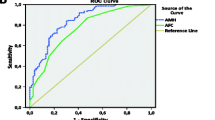Abstract
Objectives
The aim of this study was to determine day 3 Serum AMH, FSH, LH, Estradiol (E2), Inhibin B levels, ovarian volume, and antral follicular count to assess ovarian function.
Methods
This study was conducted on 130 infertile women between age 18 and 43 years. Day 3 Serum AMH level was estimated by sandwich enzyme immunoassay; Serum FSH, S. LH, S. E2, by solid-phase two-site chemiluminescent immunometric assay; Inhibin B by ELISA; and Ovarian volume and AFC, by transvaginal ultrasonography.
Results
With advancing age, Serum AMH level (p < 0.0001), AFC (p < 0.05), ovarian volume (>0.05), and Inhibin B (>0.05) were decreased, and Serum FSH (p < 0.05), LH (p > 0.05), and E2 (p < 0.05) were increased. Serum AMH level was 4–6.8 ng/ml with optimal fertility in 26.15 % cases and 2.2–4.0 ng/ml with satisfactory fertility in 53.85 % cases. Serum AMH levels were more strongly correlated with AFC (p < 0.0001) and ovarian volume (p < 0.0001).
Conclusion
Serum AMH levels were more robustly correlated with AFC than FSH, LH, E2, and Inhibin B on day 3 of the cycle. This suggested that serum AMH might be taken as single test to reflect ovarian reserve.
Similar content being viewed by others
References
Van Rooij IA, Broekmans FJ, te Velde ER, et al. Serum anti-Mullerian hormone levels: a novel measure of ovarian reserve. Hum Reprod. 2002;17:3065–71.
Fanchin R, Schonauer LM, Righini C, et al. A Serum anti-Mullerian hormone is more strongly related to ovarian follicular status than serum inhibin B, estradiol, FSH and LH on day 3. Hum Reprod. 2003;18:323–7.
Ng EH, Yeung WS, Fong DY, et al. Effects of age on hormonal and ultrasound markers of ovarian reserve in Chinese women with proven fertility. Human Reprod. 2003;18:2169–74.
Muttukrishna S, Suharjono H, Sathanandan M, et al. Inhibin B and anti-Mullerian hormone: markers of ovarian response in IVF/ICSI patients. BJOG. 2004;111:1248–53.
Muttukrishna S, McGarrigle H, Wakim R, et al. Antral follicle count, anti-Mullerian hormone and inhibin B: predictors of ovarian response in assisted reproductive technology? BJOG. 2005;112:1384–90.
Van Rooij IA, Broekmans FJ, Scheffer GJ, et al. Serum anti-Mullerian hormone levels best reflect the reproductive decline with age in normal women with proven fertility: a longitudinal study. Fertil Steril. 2005;83:979–87.
La Marca A, Volpe A. Anti-Mullerian hormone (AMH) in female reproduction: is measurement of circulating AMH a useful tool? Clin Endocrinol. 2006;64:603–10.
Knauff EA, Eijkemans MJ, Lambalk CB, et al. Anti-Mullerian hormone, inhibin B, and antral follicle count in young women with ovarian failure. J Clin Endocrinol Metab. 2009;94(3):786–92.
Author information
Authors and Affiliations
Corresponding author
Rights and permissions
About this article
Cite this article
Dayal, M., Sagar, S., Chaurasia, A. et al. Anti-Mullerian Hormone: A New Marker of Ovarian Function. J Obstet Gynecol India 64, 130–133 (2014). https://doi.org/10.1007/s13224-013-0482-3
Received:
Accepted:
Published:
Issue Date:
DOI: https://doi.org/10.1007/s13224-013-0482-3



